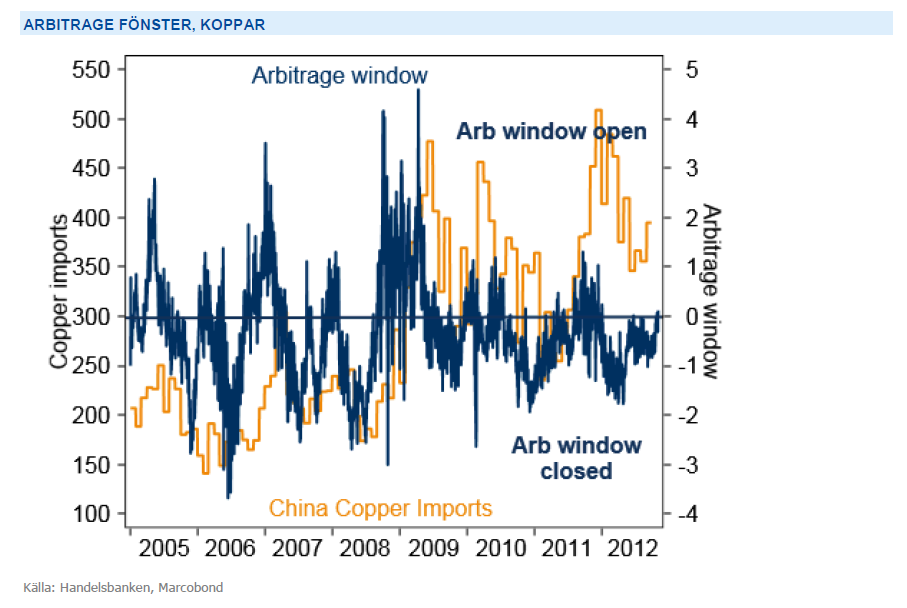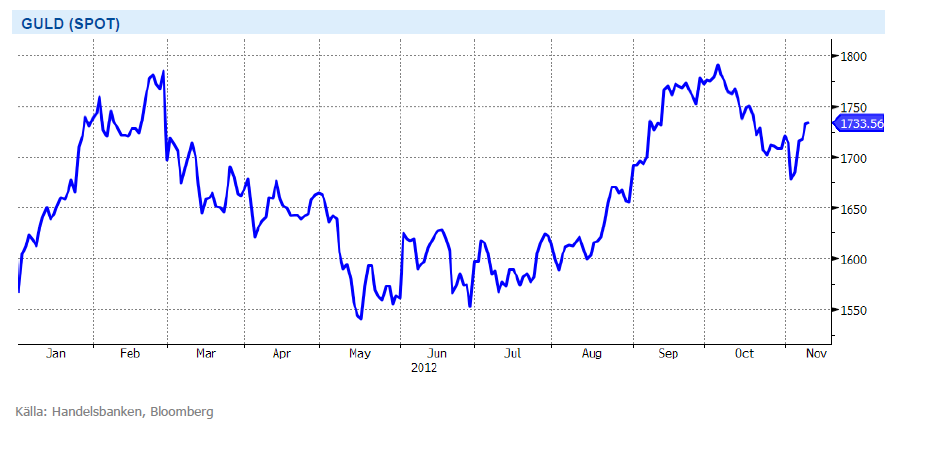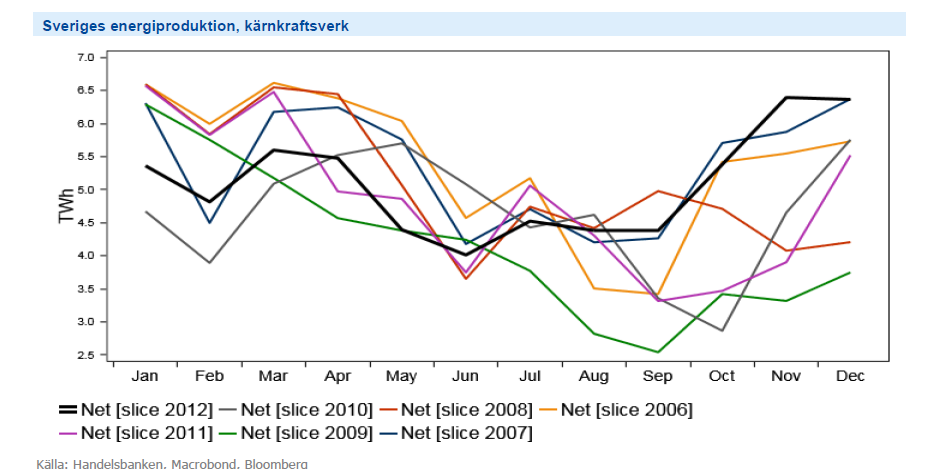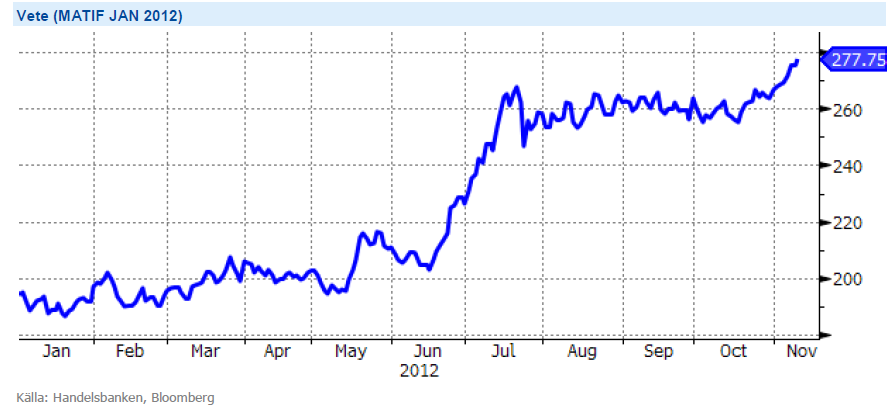Analys
SHB Råvarubrevet 9 november 2012
 Iskall konjunkturell vinter i Sverige – men gröna bambuskott i Kina
Iskall konjunkturell vinter i Sverige – men gröna bambuskott i Kina
Risksentimentet har haft det kämpigt de senaste veckorna, trots gröna skott i Kina och USA. Marknaden har åter tvingats fokusera på Grekland och Spanien, mestadels tack vare sedvanligt politiskt käbbel. Samtidigt har oron kring det finanspolitiska stupet kommit som ett brev på posten efter USA:s presidentval.
Förra året enades USA:s politiker bland annat om att tillfälligt förlänga de skattelättnader som infördes av Bush 2001-03. Utöver dessa kommer också ökat skattetryck från Obamas sjukvårdspaket. Sammantaget skulle oförändrad finanspolitik motsvara skattehöjningar och utgiftsminskningar på nära 4 % av BNP nästa år. Med dagens tillväxttakt på drygt 2 % skulle ett fall utför budgetstupet föra USA in i en ny recession. Vi räknar emellertid med att det politiska systemet lyckas komma överrens, måhända under årets sista skälvande timmar. På fredagsmorgonen kom bra oktoberdata från Kina som styrker vår positiva syn på basmetaller och som bekräftar att vändningen i den kinesiska konjunkturen i september fortsätter. Grekkaos och fiscal cliff spred dock smolk i glädjebägaren. Samtidigt har det kommit mycket dålig data från Sverige men den ska man inte tolka som negativt för råvarorna som handlas på världsmarknaden.
Basmetallerna
Kinas återhämtning finns framför oss
Basmetallerna startade veckan med stigande priser men vände ned igen då dollar stärktes efter valet i USA. Från måndagens öppning stänger kopparn på -1,1 %, aluminium är ned med 0,6 % medan nickel är princip oförändrad. Imorse fick vi dock positiv data från Kina där industriproduktionen kom in på 9,6 % (väntat 9,4%) i oktober jämfört med 9,2% i september och investeringar (FAI) YTD kom in på 20,7 % (väntat 20,6%) mot 20,5% i september.
Kopparlagren i Kina (både bonded och SHFE) är på rekordnivåer och trots att Kina importerat mycket de senaste månaderna har lagren utanför Kina inte minskat vilket vittnar om en fortsatt svag konsumtion globalt (ex Kina). Totala lager ligger nu på ca 1.2 miljoner ton (+0.3 miljoner ton sen i somras) men vi förväntar oss att överskottet reduceras något mot slutet av året/inledningen av 2013 i takt med att kinesiska verk nu betat av sina lager och börjar bygga upp nya. Kopparbalansen ser vidare ut att bli negativ under 2013 för första gången på tre år. Arbitragefönstret mellan Shanghai och LME åter öppet (se blå graf nedan som nu är positiv) vilket bör ge stöd åt Kinesisk import och kopparpriset. Vi behåller vår positiva vy för basmetaller.
Under oktober har basmetallerna haft ett kraftigt ras, efter den kraftiga uppgången i september. Finansmarknaden hade handlat in för mycket på för kort tid. Däremot ser Kinadata allt bättre ut nu. Vi tror på: Vi tror på: BASMET H
Ädelmetaller
Fiscal cliff stärker guldet
Ädelmetallerna har hämtat sig från förra veckans fall, och Handelsbankens ädelmetallindex har stigit med nästan 3 % sedan fredagens stängning. Med en omvald Barack Obama i vita huset är diskussionen kring fiscal cliff (finanspolitiska stupet) åter på agendan vilket har fått guldet att stiga i värde. Fiscal cliff tillsammans med förnyad oro kring eurokrisen ökar investerares vilja att fly till guldet. Guldet handlas nu på 1733 USD/uns, vilket är 3,3 % högre än veckans öppning.
I och med att Obama blev omvald så är chanserna för fortsatt mjuk penningpolitik mycket större än om Romney blivit vald till USA:s president vilket talar till guldets fördel. Vi behåller vår positiva vy för hela sektorn.
Rapporterna kring strejkerna i de sydafrikanska gruvorna har tystnat, vilket tyder på att situationen återgått till det normala – dock med betydligt färre arbetare i gruvorna.
Vi är fortsatt positiva till ädelmetaller med den främsta anledningen att vi tror på fortsatt mjuk penningpolitik från FED och att central bankernas stimulanser forstätter att ge stöd. Vi tror på: ADELMET H
Energi
Fortsatt bensinbrist i USA
Omvalet av Barack Obama som USA:s president har inte haft något tydlig inverkan på oljepriset. Däremot är det fortfarande bensinbrist i spåren efter stormen Sandy, endast en fjärdedel av bensinstationerna i New York City, Long Island och New Jersey är i drift. Nu sätts åtgärder in för att försöka lindra problemet. Det beredskapslager som inrättades 2000 öppnas nu energidepartementet. Försvaret har fått i uppgift att köpa in och distribuera inte mindre än 380 000 fat blyfri bensin och 317 000 fat diesel till de berörda områdena. Brent-oljan handlas i skrivande stund på 107 USD/fat vilket är 1,15 % högre än måndagens öppning, i onsdag handlas dock oljan upp på dryga 111 USD/fat.
Marginellt ned på elmarknaden under veckan och även om vi inte förväntar oss några större rörelser är sentimentet fortsatt svagt. Såväl kol som utsläppsrätter handlas oförändrat och ser vi till vädret förväntas temperaturen ligga en ca 3 grader över normalt de kommande tio dagarna medan nederbördsmängderna beräknas till ca 7 TWh vilket är normalt denna tid på året. En del av den förväntade nederbörden uteblev vilket innebär att energibalansen minskar till ca 8.5 TWh. Svensk kärnkraft går mot bästa novemberproduktionen sedan Barsebäck stängdes (maj 2005) och december kan bli ännu bättre då vår tionde och minsta reaktor, Oskarshamn 1, fortfarande står stilla. Övriga 9 reaktorer är nu igång efter årets revision (underhåll) och då är risken mycket liten att de inte levererar i vinter. Notera den bedrövliga vintern 09/10 i bilden nedan.
Oljan har sett allt svagare ut och vi fortsätter tycka att underliggande fundamenta är väl balanserad. Vi ser även att förutsättningarna för fortsatt lågt elpris kvarstår. Vi håller en neutral syn på energisektorn.
Livsmedel
Global veteproduktion väntas justeras ned
Terminspriser på vete har gått upp sedan förra veckan i både Chicago och Paris. Det amerikanska höstvetet lider fortfarande av torrt och varmt väder och någon klar bättring ser inte ut att vara i sikte. Skicket på grödan bedöms vara rekorddåligt och ytterligare försämring är nog att vänta. I Argentina har det blivit lite torrare, vilket gynnar pågående skörd. Lite regn har fallit i de östra delarna av Australien, generellt sett är det dock väldigt torrt. Den nederbörd som fallit lär nog inte ha någon större effekt, men bromsar en fortsatt nedgång. I dagens WASDE-rapport från USDA bör produktionssiffrorna för den australiensiska skörden justeras ned från föregående rapports 23 miljoner ton, 20 miljoner ton eller strax därunder är nog mer rimligt.
I EU är det fortfarande blött i en del områden och tiden för sådd löper snart ut. I Frankrike rapporterades tidigare i veckan om att sådden var avklarad endast till 64 procent, att jämföra med 88 procent vid samma tid förra året. Än värre är det i Storbritannien där det nu talas om att höstsådden kanske inte når mycket mer än 60 procent av tidigare planerad areal. I dagens WASDE-rapport väntas inga större förändringar för det amerikanska vetet. För den globala produktionen väntas däremot nedjusteringar för främst Australien och Argentina – förmodligen dock inte till fullt så låga nivåer som de lokala analytikernas utan kvar något över likt föregående månad. Med försämrade förutsättningar för nästa års skörd bör en eventuell nedsida vara väldigt begränsad. En bra start på grödan är givetvis att föredra men mycket kan hända tills nästa års skörd och vi har sett förr att de höstsådda grödorna återhämtat sig väl efter vintern.
Vi ser soja, majs och vete som klara säljcase där vi väntar oss prisfall före jul men senast till påsk. Vi tror på: LIVSMEDEL S H
Handelsbankens Råvaruindex
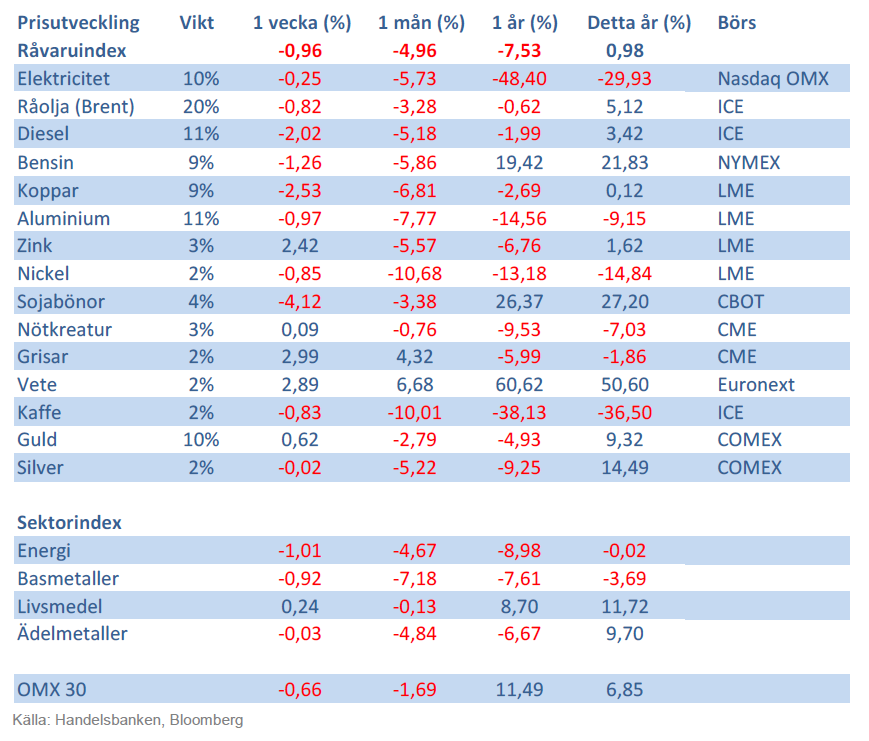
Handelsbankens råvaruindex består av de underliggande indexen för respektive råvara. Vikterna är bestämda till hälften från värdet av global produktion och till hälften från likviditeten i terminskontrakten.
[box]SHB Råvarubrevet är producerat av Handelsbanken och publiceras i samarbete och med tillstånd på Råvarumarknaden.se[/box]
Ansvarsbegränsning
Detta material är producerat av Svenska Handelsbanken AB (publ) i fortsättningen kallad Handelsbanken. De som arbetar med innehållet är inte analytiker och materialet är inte oberoende investeringsanalys. Innehållet är uteslutande avsett för kunder i Sverige. Syftet är att ge en allmän information till Handelsbankens kunder och utgör inte ett personligt investeringsråd eller en personlig rekommendation. Informationen ska inte ensamt utgöra underlag för investeringsbeslut. Kunder bör inhämta råd från sina rådgivare och basera sina investeringsbeslut utifrån egen erfarenhet.
Informationen i materialet kan ändras och också avvika från de åsikter som uttrycks i oberoende investeringsanalyser från Handelsbanken. Informationen grundar sig på allmänt tillgänglig information och är hämtad från källor som bedöms som tillförlitliga, men riktigheten kan inte garanteras och informationen kan vara ofullständig eller nedkortad. Ingen del av förslaget får reproduceras eller distribueras till någon annan person utan att Handelsbanken dessförinnan lämnat sitt skriftliga medgivande. Handelsbanken ansvarar inte för att materialet används på ett sätt som strider mot förbudet mot vidarebefordran eller offentliggörs i strid med bankens regler.
Analys
More weakness and lower price levels ahead, but the world won’t drown in oil in 2026

Some rebound but not much. Brent crude rebounded 1.5% yesterday to $65.47/b. This morning it is inching 0.2% up to $65.6/b. The lowest close last week was on Thursday at $64.11/b.

The curve structure is almost as week as it was before the weekend. The rebound we now have gotten post the message from OPEC+ over the weekend is to a large degree a rebound along the curve rather than much strengthening at the front-end of the curve. That part of the curve structure is almost as weak as it was last Thursday.
We are still on a weakening path. The message from OPEC+ over the weekend was we are still on a weakening path with rising supply from the group. It is just not as rapidly weakening as was feared ahead of the weekend when a quota hike of 500 kb/d/mth for November was discussed.
The Brent curve is on its way to full contango with Brent dipping into the $50ies/b. Thus the ongoing weakening we have had in the crude curve since the start of the year, and especially since early June, will continue until the Brent crude oil forward curve is in full contango along with visibly rising US and OECD oil inventories. The front-month Brent contract will then flip down towards the $60/b-line and below into the $50ies/b.
At what point will OPEC+ turn to cuts? The big question then becomes: When will OPEC+ turn around to make some cuts? At what (price) point will they choose to stabilize the market? Because for sure they will. Higher oil inventories, some more shedding of drilling rigs in US shale and Brent into the 50ies somewhere is probably where the group will step in.
There is nothing we have seen from the group so far which indicates that they will close their eyes, let the world drown in oil and the oil price crash to $40/b or below.
The message from OPEC+ is also about balance and stability. The world won’t drown in oil in 2026. The message from the group as far as we manage to interpret it is twofold: 1) Taking back market share which requires a lower price for non-OPEC+ to back off a bit, and 2) Oil market stability and balance. It is not just about 1. Thus fretting about how we are all going to drown in oil in 2026 is totally off the mark by just focusing on point 1.
When to buy cal 2026? Before Christmas when Brent hits $55/b and before OPEC+ holds its last meeting of the year which is likely to be in early December.
Brent crude oil prices have rebounded a bit along the forward curve. Not much strengthening in the structure of the curve. The front-end backwardation is not much stronger today than on its weakest level so far this year which was on Thursday last week.

The front-end backwardation fell to its weakest level so far this year on Thursday last week. A slight pickup yesterday and today, but still very close to the weakest year to date. More oil from OPEC+ in the coming months and softer demand and rising inventories. We are heading for yet softer levels.

Analys
A sharp weakening at the core of the oil market: The Dubai curve

Down to the lowest since early May. Brent crude has fallen sharply the latest four days. It closed at USD 64.11/b yesterday which is the lowest since early May. It is staging a 1.3% rebound this morning along with gains in both equities and industrial metals with an added touch of support from a softer USD on top.

What stands out the most to us this week is the collapse in the Dubai one to three months time-spread.
Dubai is medium sour crude. OPEC+ is in general medium sour crude production. Asian refineries are predominantly designed to process medium sour crude. So Dubai is the real measure of the balance between OPEC+ holding back or not versus Asian oil demand for consumption and stock building.
A sharp weakening of the front-end of the Dubai curve. The front-end of the Dubai crude curve has been holding out very solidly throughout this summer while the front-end of the Brent and WTI curves have been steadily softening. But the strength in the Dubai curve in our view was carrying the crude oil market in general. A source of strength in the crude oil market. The core of the strength.
The now finally sharp decline of the front-end of the Dubai crude curve is thus a strong shift. Weakness in the Dubai crude marker is weakness in the core of the oil market. The core which has helped to hold the oil market elevated.
Facts supports the weakening. Add in facts of Iraq lifting production from Kurdistan through Turkey. Saudi Arabia lifting production to 10 mb/d in September (normal production level) and lifting exports as well as domestic demand for oil for power for air con is fading along with summer heat. Add also in counter seasonal rise in US crude and product stocks last week. US oil stocks usually decline by 1.3 mb/week this time of year. Last week they instead rose 6.4 mb/week (+7.2 mb if including SPR). Total US commercial oil stocks are now only 2.1 mb below the 2015-19 seasonal average. US oil stocks normally decline from now to Christmas. If they instead continue to rise, then it will be strongly counter seasonal rise and will create a very strong bearish pressure on oil prices.
Will OPEC+ lift its voluntary quotas by zero, 137 kb/d, 500 kb/d or 1.5 mb/d? On Sunday of course OPEC+ will decide on how much to unwind of the remaining 1.5 mb/d of voluntary quotas for November. Will it be 137 kb/d yet again as for October? Will it be 500 kb/d as was talked about earlier this week? Or will it be a full unwind in one go of 1.5 mb/d? We think most likely now it will be at least 500 kb/d and possibly a full unwind. We discussed this in a not earlier this week: ”500 kb/d of voluntary quotas in October. But a full unwind of 1.5 mb/d”
The strength in the front-end of the Dubai curve held out through summer while Brent and WTI curve structures weakened steadily. That core strength helped to keep flat crude oil prices elevated close to the 70-line. Now also the Dubai curve has given in.

Brent crude oil forward curves

Total US commercial stocks now close to normal. Counter seasonal rise last week. Rest of year?

Total US crude and product stocks on a steady trend higher.

Analys
OPEC+ will likely unwind 500 kb/d of voluntary quotas in October. But a full unwind of 1.5 mb/d in one go could be in the cards

Down to mid-60ies as Iraq lifts production while Saudi may be tired of voluntary cut frugality. The Brent December contract dropped 1.6% yesterday to USD 66.03/b. This morning it is down another 0.3% to USD 65.8/b. The drop in the price came on the back of the combined news that Iraq has resumed 190 kb/d of production in Kurdistan with exports through Turkey while OPEC+ delegates send signals that the group will unwind the remaining 1.65 mb/d (less the 137 kb/d in October) of voluntary cuts at a pace of 500 kb/d per month pace.

Signals of accelerated unwind and Iraqi increase may be connected. Russia, Kazakhstan and Iraq were main offenders versus the voluntary quotas they had agreed to follow. Russia had a production ’debt’ (cumulative overproduction versus quota) of close to 90 mb in March this year while Kazakhstan had a ’debt’ of about 60 mb and the same for Iraq. This apparently made Saudi Arabia angry this spring. Why should Saudi Arabia hold back if the other voluntary cutters were just freeriding? Thus the sudden rapid unwinding of voluntary cuts. That is at least one angle of explanations for the accelerated unwinding.
If the offenders with production debts then refrained from lifting production as the voluntary cuts were rapidly unwinded, then they could ’pay back’ their ’debts’ as they would under-produce versus the new and steadily higher quotas.
Forget about Kazakhstan. Its production was just too far above the quotas with no hope that the country would hold back production due to cross-ownership of oil assets by international oil companies. But Russia and Iraq should be able to do it.
Iraqi cumulative overproduction versus quotas could reach 85-90 mb in October. Iraq has however steadily continued to overproduce by 3-5 mb per month. In July its new and gradually higher quota came close to equal with a cumulative overproduction of only 0.6 mb that month. In August again however its production had an overshoot of 100 kb/d or 3.1 mb for the month. Its cumulative production debt had then risen to close to 80 mb. We don’t know for September yet. But looking at October we now know that its production will likely average close to 4.5 mb/d due to the revival of 190 kb/d of production in Kurdistan. Its quota however will only be 4.24 mb/d. Its overproduction in October will thus likely be around 250 kb/d above its quota with its production debt rising another 7-8 mb to a total of close to 90 mb.
Again, why should Saudi Arabia be frugal while Iraq is freeriding. Better to get rid of the voluntary quotas as quickly as possible and then start all over with clean sheets.
Unwinding the remaining 1.513 mb/d in one go in October? If OPEC+ unwinds the remaining 1.513 mb/d of voluntary cuts in one big go in October, then Iraq’s quota will be around 4.4 mb/d for October versus its likely production of close to 4.5 mb/d for the coming month..
OPEC+ should thus unwind the remaining 1.513 mb/d (1.65 – 0.137 mb/d) in one go for October in order for the quota of Iraq to be able to keep track with Iraq’s actual production increase.
October 5 will show how it plays out. But a quota unwind of at least 500 kb/d for Oct seems likely. An overall increase of at least 500 kb/d in the voluntary quota for October looks likely. But it could be the whole 1.513 mb/d in one go. If the increase in the quota is ’only’ 500 kb/d then Iraqi cumulative production will still rise by 5.7 mb to a total of 85 mb in October.
Iraqi production debt versus quotas will likely rise by 5.7 mb in October if OPEC+ only lifts the overall quota by 500 kb/d in October. Here assuming historical production debt did not rise in September. That Iraq lifts its production by 190 kb/d in October to 4.47 mb/d (August level + 190 kb/d) and that OPEC+ unwinds 500 kb/d of the remining quotas in October when they decide on this on 5 October.

-

 Nyheter4 veckor sedan
Nyheter4 veckor sedanMahvie Minerals i en guldtrend
-

 Analys4 veckor sedan
Analys4 veckor sedanVolatile but going nowhere. Brent crude circles USD 66 as market weighs surplus vs risk
-

 Nyheter4 veckor sedan
Nyheter4 veckor sedanAktier i guldbolag laggar priset på guld
-

 Nyheter4 veckor sedan
Nyheter4 veckor sedanKinas elproduktion slog nytt rekord i augusti, vilket även kolkraft gjorde
-

 Nyheter3 veckor sedan
Nyheter3 veckor sedanTyskland har så höga elpriser att företag inte har råd att använda elektricitet
-

 Nyheter4 veckor sedan
Nyheter4 veckor sedanGuld når sin högsta nivå någonsin, nu även justerat för inflation
-

 Nyheter4 veckor sedan
Nyheter4 veckor sedanDet stigande guldpriset en utmaning för smyckesköpare
-

 Analys4 veckor sedan
Analys4 veckor sedanWaiting for the surplus while we worry about Israel and Qatar



